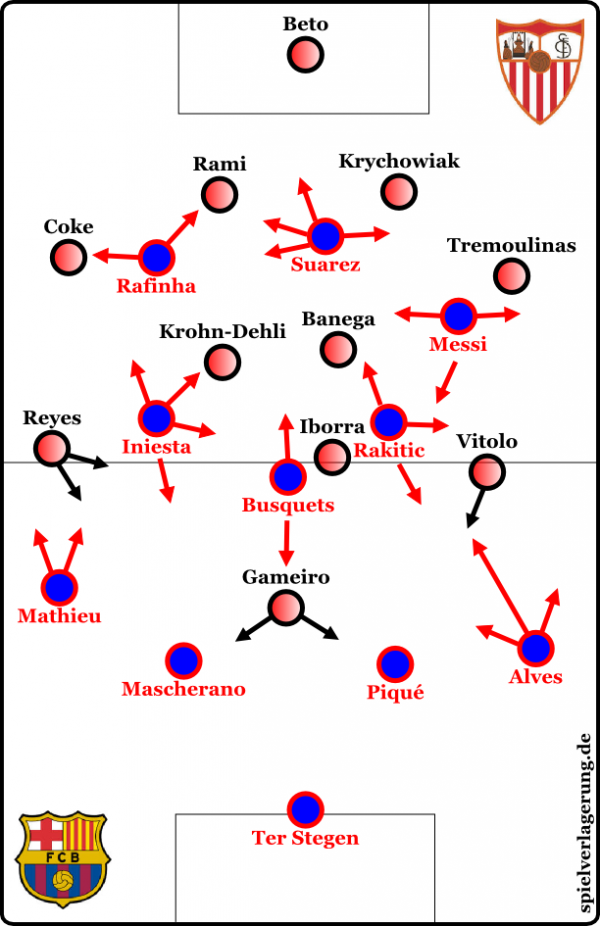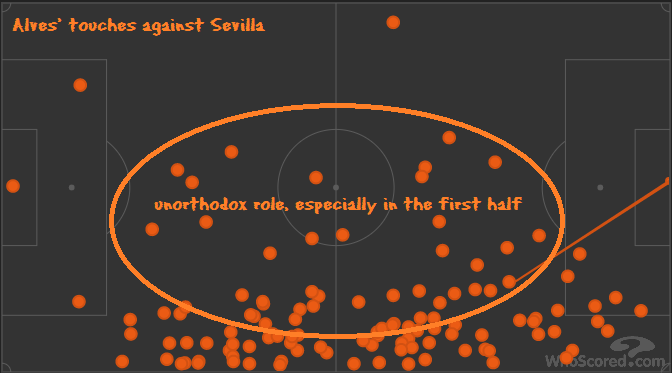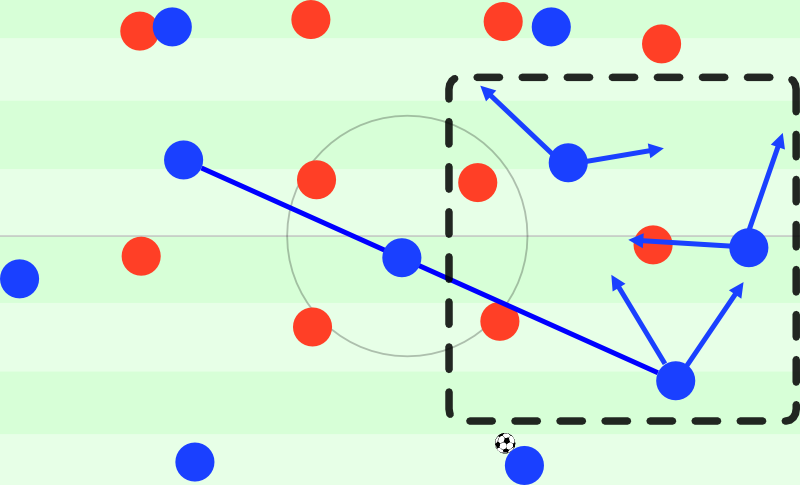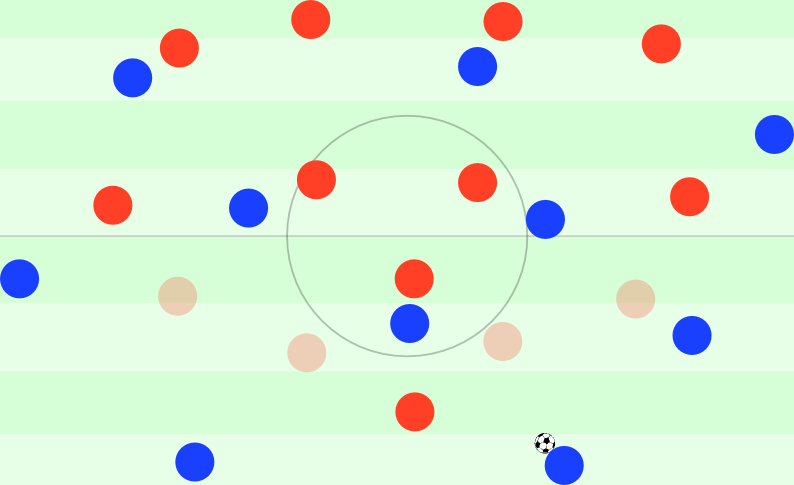Match Analysis: European Supercup Barcelona vs Sevilla
European Supercup! In the Catalan-Spanish final Barcelona was able to win after going down an early goal. With a fast comeback they got a lead and in the end won in spectacular fashion. They showed most of their great strengths of their historic last season but also weaknesses which might prevent another such season.
Barcelona start in their usual system and smaller adjustments
The Catalans used in this game again their system of last year. Although they started with a less offensively talented left full back in Mathieu (compared to Alba), the French was often earlier and clearly higher positioned than his pendant on the other side, Dani Alves.
Alves at times created a back three in the first line with the two center backs. He only rarely and late advanced wide on the wing towards forward as he was much more oriented towards the center. Often he was positioned in the right half space and involved in the ball circulation there. Because he did this over the whole pitch he even had some touches in the middle of the second and third line. This seemed in the 1st half more extreme than in the 2nd part of last season.
In general this role suits Alves very well. He has a good intuition in his movement play, he’s creative, very good in combinations and technically strong. Due to his abilities in ball retention but his lesser athleticism than in 2008-2012 he is probably better in this position than in his classical role as winger disguised as full back. Also he’s very hard to defend now as he’s moving flexibly between zones and overloading them. That creates problems for the opposition in their marking scheme as the responsibilities and spacing get messed up; especially with a player like Messi being near these zones, too.
Another key in this system is Rakitic. He often moves laterally from the center to the right wing with Messi as nominal right winger who likes to go towards the middle and act as playmaker. But Messi can stay extremely wide on the wing and focus on getting the ball into isolated situations for dribbles; Rakitic and Alves being half right do not only give him options for combinations but also open space and isolate Messi’s defender often from his team mates. Rakitic also profits from Alves as he balances his forward runs (used to open space for Messi and give a passing option between the lines).
There were even situations with all three quite narrow. This was balanced by their ability to combine even in tight spaces and Suarez moving towards the side in the last line. Still, a few times they isolated themselves which would only become a real problem in the 2nd half.
When Messi was in the middle there were different positional structures. For instance, after about twenty minutes Alves started to play more often wider and Rakitic dropped. He’d build a double pivot situationally with Busquets or even drop deeper than Busquets towards the defensive right half space. It was interesting how Rakitic, Busquets and Iniesta formed a diagonal line through midfield from right defensive half space to left offensive half space.
Iniesta was able to drop situationally deeper and pick up balls, too, but with this spacing Sevilla had problems in disturbing Barcelona’s build up.
Messi and Iniesta were able to create from their higher positions or lure opponents towards them. They played through the gaps forward (to narrow winger Rafinha and the wide striker Suarez) or pass back and switch the play – with the central midfielders and the center backs – to the other side. Suarez’ disallowed goal in minute 28 for instance was created through a staggering with Rakitic slightly wider, Alves besides him, Iniesta half left, Messi like a number ten and Suarez with Rafinha upfront between full backs and center backs. This resembled a 4-3-3-diamond formation.
Against the ball Barcelona used a 4-1-2-3 formation at the start in higher press although Messi would often stay inactive and the central midfielders were very flexible and active in leaving their positions.
Thus there were situations in the first half where Iniesta supported Suarez upfront, just to change later with Busquets being the highest midfielder in pressing. This happened surprisingly often and it even lead to Suarez’ goal due to Busquets winning the ball very high. Also Rakitic was able to act as higher central midfielder and press higher on the half right or move behind Messi to cover on the wing.
In deeper press there still were problems with movement and compactness visible. Although Busquets a few times left the line towards the wings behind Iniesta and Rakitic which created interesting coverage but often there were big gaps centrally and on the wings, too. While intensity until the 4-1 in higher press was very good as was the flexibility, there is work to do in terms of synchronization of the individuals in group tactical movement and compactness in general.
SEVILLA BETWEEN 4-2-3-1 AND 4-4-1-1
In the first minutes Sevilla gained the lead due to a great free kick of Ever Banega. But it wasn’t Banega who started as second striker against the ball but Iborra. He played some kind of man marking on Busquets at start where he positioned himself tight to Busquets and behind him, which created a 4-4-1-1. The wingers were relatively deep and narrow. Also Iborra moved towards Rakitic a few times when the ball was on the right side. An important aspect was the situational man marking within the formation and the very aggressive movement focused on leaving the line and gaining access into duels.
This might have been their downfall at start; mostly psychologically. Maybe it were the two free kick goals of Messi and the sudden change of lead which changed their style. Maybe it was a conscious decision of Emery? But Sevilla didn’t only seem less passive due to the better and fast combinations by Barcelona but also in general. Their movement in press was slower and more passive, perhaps not to risk any more fouls.
Iborra changed his role, too. He now started to be in front of Busquets more often and take him into his covering shadow while he was more in a line with the striker (Gameiro) and thus a 4-4-2. They also had some 4-2-3-1 and 4-2-4-0 formations due to the wingers now being higher and at times pressing even towards the middle in front of the pivots although without really having access or being consistent.
For a long time Barcelona did very well and only gave Sevilla a few opportunities.
AUTOMATIZED VARIABILITY ALLOWS BARCELONA TO DOMINATE
Obviously Barcelona profited mostly from their enormous individual quality and while they were unclean in some (defensive) aspects, it was a very good performance for a long time. It showed that they probably train specific structures in build up based on the zonal orientations of Messi, Alves and Rakitic, where the latter two support the first one.
Thus they were hard to predict as they were able to vary their position and role fast and the others in the team adapted to it well. From the middle of the first half for instance there was Rakitic more often very deep on the right whereas Alves started the game much deeper and more central than later on. Because of this it’s also hard to define Barcelona’s structure in a given moment and they also don’t behave the same in similar situations; especially Messi’s unpredictability is key here.
Later on Mathieu got more active on the left which acted mostly as possibility to switch and open space. It seemed to be an easy win for Barcelona – until …
HIGHER PRESSING, BARCELONA SHOWS WEAKNESSES AND PSYCHOLOGY
After the 3-1 and then the 4-1 the game seemed practically over. But not only Barcelona got careless (visible on the behavior in defensive transition, for instance), Sevilla got better. They started to press higher and more with similar man orientations and aggressiveness like in the beginning. Barcelona’s lessened and simplified movement to dismark themselves led to problems in build up. Sevilla pushed their wingers higher in press and the full backs too who often left the back line and were positioned in Barcelona’s half now.
Also the change of Banega to play higher (Iborra deeper and then subbed) and the introduction of Konoplyanka helped. The lack of compactness of Barcelona and the worse defensive activity, especially in transitioning against the ball, showed too. Often it was an unclean 4-1-3-2 or 4-4-2 with an inactive Messi. Only in the end of the regular time Luis Enrique subbed Bartra in to push Mascherano in midfield and create a cleaner 4-4-2 with Sergi Roberto on the left wing (Iniesta out) and Rakitic on the right one against the ball.
The biggest chances for Sevilla happened after winning the ball and fast transition with longer passes. There were open spaces on the sides and in front of the defense, which made Barcelona’s defending in the box less stable and less successful. Due to the worse compactness and transitioning this showed extremely after Sevilla’s wing attacks. They got stretched and lacked players to fill out the back line thus opening space after crosses in the box and also in defending cutbacks, etc.
The substitutions made Barcelona individually worse and this mixture plus some luck in finishing (of course in a 5-4!) lead to Sevilla’s comeback. They were also more often positioned in something akin to a 4-1-4-1 or 4-5-1 situationally and were more present centrally.
In overtime Luis Enrique reacted and brought the fresh Pedro for more dynamic from the left wing again and a more offensive but also more controlled system. The game normalized, Sevilla got more passive and deeper again and the rhythm was – due to the exhaustion of the players – less fast and spectacular than earlier on. It was Pedro, rumored to go to Manchester United, who scored the winning goal in the end.
* Rene Maric is a football analyst on Spielverlagerung.de

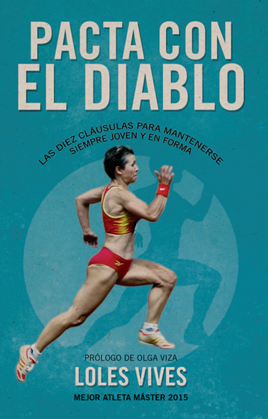
BUSCADOR DE CATEGORÍAS
BUSCADOR POR MES
ÚLTIMOS TWEETS
Tweets por @martiperarnauSÍGUENOS EN FACEBOOK




